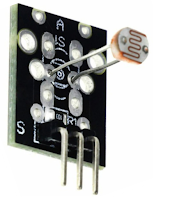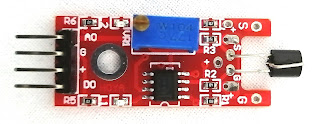Arduino Sensors for Electronics Projects
What is Sensor?
A Sensor is a device used as the primary element that measures physical value and converts it into an electrical signal. Also, we can say that the sensor is a transducer. It measures temperature, distance, light, sound, etc.
Sensors and actuators are widely used in Arduino projects. These sensors come with a kit or can be purchased separately. Some of them are compatible with Arduino Uno boards and also Raspberry Pi and other electronic modules. There are a lot of types of Arduino sensor kits available in the market.
How many types of Arduino Sensors?
There are a lot of sensors used in electronics projects, e.g. robotics cars, moving objects, flying drones, IoT(internet of things), sound and light operation, etc. Here is a list of 45 in 1 electronic sensor that comes with an Arduino sensors kit, and the details of their applications.
Analog temperature Sensors
KY 013 Temperature Sensor
KY-013 is an analog temperature sensor module. It includes an NTC (negative temperature coefficient) thermistor. KY-13 used a bead-type thermistor, made with platinum and alloy materials. NTC generates an analog signal and it measures temperatures from -55°C to +155°C.
Digital Temperature Module
Digital Temperature Sensor
The digital temperature sensor contains DS18B20, a digital thermometer used for measuring the temperature of any substance.
Digital Temperature Module
This is a KY-028 module used with an Arduino for temperature indication purposes. NTC thermistor is the main sensor and LM393 is a dual differential comparator (use two inputs, after comparison, the larger value to be sent to output).
Temperature and Humidity module
Most common used sensors for temperature and humidity are DHT11 and DHT22 sensors.
DHT11 Sensor
This is a DHT11 sensor for temperature and humidity measurement. The range for temperature measurement is 0 to 50 ℃. Operating voltage from 3.3 to 5V DC. The humidity measuring range is 20 to 95% RH(relative humidity).
DHT22 Sensor
DHT22 is same as DHT11 but it has better performance and accuracy than DHT11. It is known as 2302 and has wide range of measurement -40°C to 80°C with an accuracy of ±0.5°C, and humidity from 0% to 100% RH. It is slightly more expensive but response time is faster with changes.
Arduino IR sensor
IR sensor contains an infrared led (transmitter) and receiver led (photodiode). It transmits infrared light, and a photodiode detects the light. We used a potentiometer for distance adjustment.
Light Dependent Resistor(LDR)
LDR works on the principal photoconductivity. It is a light sensor that is used in automatic light-operated circuits. As it gets light on its surface, it generates a few electrons.
Joystick Module
Joystick module used in robotics projects. It has an x-axis, y-axis angle, and switch option. It is very useful for robotics arms and moving objects.
Metal Touch Sensor
It is a KY- 036 metal touch sensor used as a detection sensor. If a person/human body touches this sensor tip, it will trigger and generate an output. We can use a Led as an indication or buzzer for a sound alarm. It has a MOSFET(touch sensor) and LM386(amplifier).
Sound sensor
This is a high-sensitivity, sound sensor module. It has a condenser mic and is used for sound detection.
Arduino Laser sensor
Arduino laser sensors are very useful for switching projects. It's based on the detection of motion. It also comes with a transmitter and receiver.
Arduino optical switch
Arduino optical switch used in counting projects. We also used it for interrupting devices, measuring, and counting RPM purposes.
Passive buzzer sensor
We use the passive sensor for beep/sound alarm for many electronic circuits. We know it as the KY-012 module. It required only a low DC voltage(1.5 ~ 12) to activate.
Arduino vibration sensors
Vibration sensor
A vibration sensor is a very simple module used to sense minor vibrations. It operates if you shake the sensor. We can use it with the main door.

Arduino Shock sensor
We know this sensor as a knock sensor and a shock sensor. We used it for door-opening projects.
Mercury Tilt Switch
This is a small bulb-shaped switch filled with mercury. It is known as a KY-017 sensor. When the sensor moves and mercury touches both electrodes, the flow of current passes through the electrodes.
Hall effect Sensor
There are two types of hall effect sensors that come with the Arduino module kit. Analog Hall magnet, and Hall linear sensor. It's known as the KY-003 sensor. Its working principle is sensing magnetic fields, and sending signals to on/off the circuit or display on the screen.
Motion sensor(PIR)
The PIR sensor detects the motion of any object passing through it. This is a passive infrared sensor that measures motion by infrared radiation. It has a two-sensor transmitter and receiver that sense atmospheric heat.
Arduino Ultrasonic sensor
Ultrasonic sensors work on ultrasonic sound waves. These sensors have a transmitter and receiver in the same module. It is very sensitive and measures the length of the object very precisely.
Relay module
The relay module is a part of the sensor kit. We use it for switching. We used a relay if there are two different supplies to energize a circuit, e.g. low power supply and high. The relay module will operate with low power and transfer high voltage through its contacts.
Arduino potentiometer
This is a simple 10 k ohm potentiometer used to limit the resistance value of any circuit. It has a knob to vary the resistance. We can adjust the output voltage with the moving knob clockwise or anticlockwise. In the Arduino project, it is used to control the led light.
Arduino component kit
We use many electronic pieces of equipment in our routine life that may including Arduino sensors or other electronic IoT sensors and actuators.
Additionally, these sensors work with Raspberry Pi, so we can refer to them as Raspberry Pi sensors. If we learn how to use them, we can understand the principle behind devices.


















